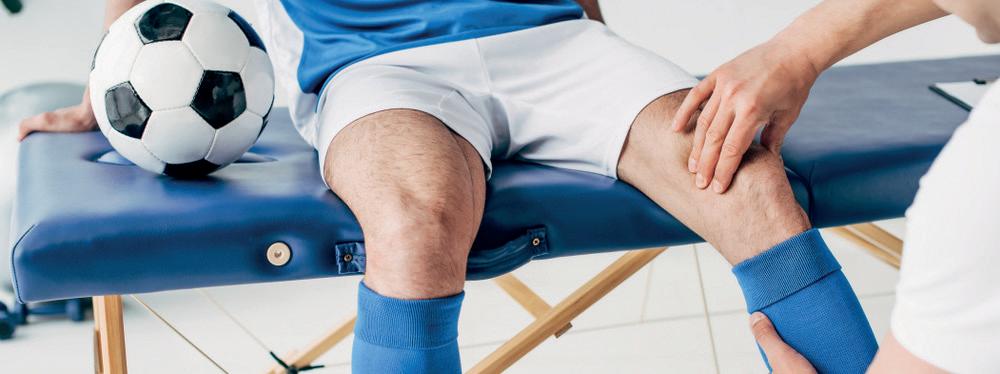
4 minute read
Physiotherapy and Sports
CENTRAL RESEARCH
Physical therapy is the science dedicated to preventing, recovering, conserving, and rehabilitating people of all ages. It provides treatment to restore patients’ bodily functions and thus reintegrate them into their activities of daily living, work, social, recreational, physical, and sports.
Advertisement
Physiotherapists provide a service to the population in which the maximum movement and functional capacity of the person is developed, maintained, and recovered when it is affected by an injury, disease, aging, disorder, or some external factor that damages their bodily function.
The physiotherapist comprehensively evaluates the patient, then diagnoses, prognoses, and carries out an intervention plan, gives treatment, and carries out an education program according to the evolution and diagnosis; It also determines the referral of the patient to another professional as an important part of multidisciplinary work.
The physiotherapy specialist uses different techniques to treat and thus maintain the well-being and health of the patient, among them are:
• Therapeutic exercise
• Manual therapy
• Physical agents (electricity, heat, cold, water, etc.).
Among the various specialties of physiotherapy is sports physiotherapy, which studies all factors, prevention, treatment, and approach of injuries related to athletes of any discipline.
The sports physiotherapist evaluates, attends, and designs a treatment to prevent, maintain and rehabilitate the athlete (amateur, health, elite or high performance). A professional who demonstrates advanced competencies in promoting safe participation in physical activity, providing counseling, and adapting rehabilitation and training interventions, for the purpose of preventing injury, restoring optimal functioning, and contributing to the improvement of athletic performance in athletes of all ages and abilities, while ensuring a high level of professional and ethical practice.
Competencies of patient management at the sports level:
- Injury prevention:
The sports physiotherapist assesses the risks of injury associated with an athlete’s participation in a specific context of sport or physical activity, informing and training athletes and other professionals in a way that reduces the occurrence and recurrence of injuries.
-Acute intervention:
Sports physiotherapists respond appropriately to acute injuries or illnesses in both training and competitive settings, using prior communication with other professionals to identify and establish roles and responsibilities.
--Rehabilitation:
The sports physiotherapist uses clinical reasoning and therapeutic skills to assess and diagnose sports-related injuries and design, implement, evaluate, and modify evidence-based interventions that aim at a safe return to the athlete’s optimal level of performance in their specific sport or physical activity.
-Performance improvement:
Sports physiotherapists contribute to improving an athlete’s performance by evaluating their physical profile, advising, and intervening to optimize conditions for maximum performance in a specific sport, within a multidisciplinary team approach.
The objectives in this specialty are:
• Adapts the body to training
• Decrease recovery time
• Reduce-prevent the risk of injury
• Improve the quality of life

These objectives will depend on each patient, the type of injury, the severity, the sport performed, or simply the physical health objectives required by the athlete.
The treatment of sports injuries changes due to the demands on the patient’s body, which need to be integrated back into their activity with a full recovery. The physiotherapist in this specialty can also participate and collaborate for the development of training, as well as give advice together with the team of physical trainers-trainers. Treatment and recovery should be done in conjunction with sports doctors and psychologists.
The vast majority of injuries to be treated are musculoskeletal, for example: stress fractures, dislocations, muscle strains, ligament and tendon injuries, sprains in their different degrees, pre and post-surgical treatment, and contusions.
This specialty allows having better management of the athlete, in a multi and interdisciplinary way, from prevention so that the athlete performs his practice with the least possible risk so that he obtains a treatment according to all therapeutic techniques and his recovery is fast and so that the player returns to his activity without complications, optimally and fully functional. Scientific evidence tells us that sports physiotherapy is an extremely important field of action, in which the professional seeks the restoration of human body movement and rapid integration into physical exercise.
LFT. Paulina Zarazúa Yáñez

Degree in Physiotherapy from the Autonomous University of Querétaro; Comprehensive Rehabilitation Center of Querétaro (CRIQ). Creator and founder of AVIS FISIOTERAPIA, an integral physiotherapy clinic.
Reference:
Pinzon, I. (2018). Perfil profesional del fisioterapeuta en actividad física, ejercicio físico y deporte. Revista Colombiana De Rehabilitación, 17 (2), 93-111. https://doi.org/10.30788/RevColReh.v17.n2.2018.325










